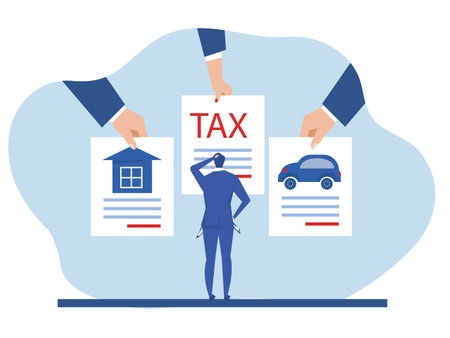Understanding Disability Insurance Benefits
Disability insurance is designed to replace a portion of your income if you’re unable to work because of an illness or injury. In the U.S., there are two main types of disability insurance: short-term and long-term coverage. Understanding how each works is important for knowing what benefits you might receive and how those benefits could impact your taxes.
What Is Disability Insurance?
Disability insurance is basically a safety net. If you get sick or hurt and can’t do your job, this insurance steps in to help cover lost wages. It won’t usually pay your full salary, but it gives you enough to help cover essentials like rent, groceries, and bills while you recover.
The Two Main Types: Short-Term vs. Long-Term Disability
| Short-Term Disability (STD) | Long-Term Disability (LTD) | |
|---|---|---|
| Covers | Temporary disabilities (like recovery from surgery or childbirth) | Serious illnesses or injuries that last months or years |
| Benefit Period | Usually 3-6 months | Several years, sometimes up to retirement age (65+) |
| Waiting Period | A few days to a couple weeks after disability occurs | Typically 90-180 days after disability begins |
| Payout Amount | About 60-70% of your regular paycheck | About 50-70% of your regular paycheck |
| Who Offers It? | Often provided by employers as part of benefits package; can also buy individual policies | Can be employer-sponsored or purchased individually; sometimes included as an add-on with life insurance policies |
How Does Disability Insurance Work in the U.S.?
If you have disability insurance through work, your employer may pay the premiums, you might pay them, or you could split the cost. Some people buy their own policies directly from an insurance company. When you become disabled and qualify for benefits, you’ll get payments based on the terms of your policy—how much, how long, and any special rules about what counts as a “disability.” These details matter not only for the coverage itself but also for how those benefits will be taxed later on.
2. When Disability Insurance Benefits Are Taxable
Understanding when your disability insurance benefits are taxable can help you avoid surprises at tax time. In the U.S., the taxability of these benefits depends on how your premiums were paid and who paid them. Here’s a breakdown of common scenarios:
Employer-Paid Premiums
If your employer pays the full cost of your disability insurance premiums, any benefits you receive from that policy are generally considered taxable income. The IRS treats this as compensation, so you’ll need to report it on your federal tax return and possibly pay state taxes, depending on where you live.
Example:
Suppose your company offers a group long-term disability plan and covers 100% of the premium. If you become disabled and start receiving monthly benefits, those payments will be taxed as ordinary income.
Group Plans with Shared Premiums
Many employers offer group disability policies where both the employer and employee share the cost of premiums. In these cases, only the portion of benefits attributable to the employer-paid premiums is taxable. The part related to your after-tax contributions is not taxed.
| Who Paid Premiums? | Are Benefits Taxable? |
|---|---|
| Employer pays 100% | Yes, fully taxable |
| You pay 100% with pre-tax dollars | Yes, fully taxable |
| You pay 100% with after-tax dollars | No, not taxable |
| Split (employer & you pay) | Taxable portion equals employer-paid percentage; your after-tax share is tax-free |
How It Works:
- If you pay your part with pre-tax dollars: Your share of benefits is also taxable.
- If you pay your part with after-tax dollars: That part of your benefits is tax-free.
- Your employer’s share: Always taxable if they paid the premiums.
Short-Term vs Long-Term Disability Plans
The same basic rules apply whether you have short-term or long-term disability coverage through work. What matters most for taxes is who paid for the policy and whether those payments were made with pre-tax or after-tax dollars.
Key Takeaway
If someone else—usually your employer—paid for all or part of your disability insurance using pre-tax dollars, expect at least some portion of your benefits to be taxable income according to IRS rules. Keeping track of how premiums are paid can make filing taxes much easier if you ever need to claim these benefits.

3. Tax-Free Disability Insurance Benefits
Understanding when your disability insurance benefits are tax-free can save you from unexpected surprises come tax season. In the U.S., whether or not you pay taxes on your disability benefits depends on several factors, especially who paid for the policy and how premiums were handled. Let’s break down the details in a way that’s easy to follow.
When Are Disability Benefits Non-Taxable?
If you pay the full premium for your disability insurance policy with after-tax dollars—that is, money that’s already been taxed—your benefit payments are generally not taxable. This rule applies to most individual policies, such as those purchased privately outside of an employer plan.
Common Scenarios Where Benefits Are Tax-Free
| Scenario | Are Benefits Taxable? | Details |
|---|---|---|
| You buy a private disability policy and pay premiums yourself (with after-tax income) | No | Your benefits are tax-free because you paid with money thats already been taxed. |
| Your employer offers a disability plan, but you pay 100% of the premium with after-tax dollars | No | Even though it’s through work, if you pay all the premiums with after-tax dollars, the benefits stay tax-free. |
| You receive supplemental coverage and pay those extra premiums yourself (after-tax) | No (on your portion) | The part of the benefit from premiums you paid after-tax is tax-free; any portion paid by your employer may be taxable. |
Why Does This Happen?
The IRS follows a simple rule: You don’t get taxed twice on the same money. So if you’ve already paid taxes on the money used for your premiums, you don’t have to pay taxes again when you receive benefits. This encourages people to secure their own protection without worrying about extra tax burdens later.
Real-Life Example: Private Policy Owner
Let’s say Sarah buys an individual long-term disability policy. She pays $50 per month out of her checking account (using her take-home pay). A year later, she suffers an injury and starts receiving monthly disability benefits. Since she used after-tax dollars for all her premiums, her monthly benefit checks are tax-free.
Key Takeaways for Planning
- Review who pays your premiums: If you’re paying with after-tax dollars, your benefits should be tax-free.
- If you’re unsure about your policy: Check with your HR department or insurance agent to clarify how your premiums are paid and whether you can adjust this for future tax advantages.
- Keep records: Hold onto proof that you paid premiums with after-tax money—especially helpful if you ever need to show the IRS why your benefits aren’t taxable.
Knowing these rules lets you better plan for financial security during tough times without facing unexpected taxes on essential income.
4. Federal vs. State Tax Considerations
When it comes to the tax treatment of disability insurance benefits, where you live can make a big difference. Let’s break down how these benefits are taxed at the federal level compared to what you might face from your state’s tax authorities.
How Disability Benefits Are Taxed Federally
At the federal level, whether your disability insurance benefits are taxable depends mostly on who paid the premiums and how they were paid:
| Who Paid Premiums? | Were Premiums Paid Pre-Tax or Post-Tax? | Are Benefits Taxable by IRS? |
|---|---|---|
| You (Employee) | Post-Tax | No |
| Your Employer | Pre-Tax (or Employer Paid) | Yes (Fully Taxable) |
| You & Employer (Split) | Mix of Pre- and Post-Tax | Partially Taxable (Proportionate) |
This means if you paid for your own policy with after-tax dollars, any money you get from a disability claim isn’t taxed by the IRS. But if your employer paid for your policy, or if you used pre-tax dollars through a workplace plan, those benefits generally count as taxable income.
State-Level Tax Rules: It Really Depends Where You Live!
States have their own rules about taxing disability insurance benefits. Some follow the federal guidelines closely, while others have unique twists. Here’s a general look at how different states treat these benefits:
| State Type | Typical Treatment of Disability Insurance Benefits | Examples |
|---|---|---|
| No State Income Tax | No state tax on disability benefits (because there’s no income tax at all!) | Florida, Texas, Nevada, Washington, Alaska, South Dakota, Wyoming |
| Follows Federal Rules | If federally taxable, then taxable by the state; if not, then not. | California*, Illinois, New York |
| Has Unique Exemptions or Credits | Some states offer extra exemptions or credits for disability income. | Pennsylvania (most private disability is not taxed), New Jersey (some exclusions apply) |
| Treats Public and Private Benefits Differently | Might tax government-provided disability but not private policies, or vice versa. | Minnesota, Wisconsin (special rules for certain plans) |
*Special Note for California Residents:
California usually does not tax Social Security Disability Insurance (SSDI) benefits and follows the federal rules for most private disability insurance payouts. However, always double-check with a local tax pro because exceptions do exist.
Key Takeaway:
The bottom line is that both where you live and who pays your premiums affect whether your disability benefits are taxed. Always look up your specific state’s rules or talk to a local tax professional to avoid surprises come tax time!
5. Smart Tax Planning Strategies
Understanding How to Minimize Taxes on Disability Insurance Benefits
Navigating the tax rules around disability insurance benefits can feel overwhelming, but a few smart planning moves can help you keep more of your money. Here are some practical tips that everyday Americans can use to lower their potential tax bill when it comes to disability insurance.
Tip 1: Pay Premiums Yourself If You Can
If you pay your own disability insurance premiums using after-tax dollars, your benefits are generally tax-free if you ever need them. But if your employer pays all or part of your premiums—and doesn’t include that cost in your taxable income—then any benefits you receive could be taxed as ordinary income. Here’s a quick comparison:
| Who Pays the Premium? | Are Benefits Taxable? |
|---|---|
| You (after-tax dollars) | No |
| Your Employer (not reported as income) | Yes |
| Your Employer (reported as income) | No |
| Split between You and Employer | Portion paid by employer is taxable |
Tip 2: Use Cafeteria Plans Wisely
A cafeteria plan lets you choose from a menu of employee benefits, often using pre-tax dollars. While this can save on current taxes, keep in mind that if you pay disability insurance premiums with pre-tax dollars through one of these plans, any future benefits will be taxable. If you prefer having potentially tax-free benefits later, consider paying those premiums with after-tax money instead.
Example:
If Jane pays her disability premium through payroll deductions under a cafeteria plan (pre-tax), her benefit checks would be subject to federal income tax if she ever files a claim. If she opts out and pays with her take-home pay (after-tax), her future disability payments would typically be tax-free.
Tip 3: Keep Good Records
It’s important to keep clear records of how your premiums were paid and who paid them. This documentation helps at tax time if you ever need to prove why your benefits should or shouldn’t be taxed. Save pay stubs, employer benefit statements, and plan documents so you have everything ready for the IRS if needed.
Record-Keeping Checklist:
- Copies of payroll deductions or canceled checks for after-tax payments
- Your employer’s annual benefit summaries
- Cafeteria plan enrollment forms (if applicable)
- Any correspondence about changes in payment structure or coverage
Tip 4: Consult a Tax Pro Before Making Changes
If you’re thinking about switching how you pay for disability insurance—like moving from an employer-paid plan to a personal policy or changing cafeteria plan elections—talk with a tax professional first. They can help you weigh the pros and cons so you make the best choice for your situation.
6. Reporting Disability Benefits on Your Tax Return
Step-by-Step Guide to Reporting Disability Insurance Benefits
Filing your taxes can feel overwhelming, especially when you receive disability insurance benefits. The good news is, you don’t need to be a tax expert to figure out where and how to report these benefits. Let’s break down the process in plain English so you know exactly what to do come tax season.
Step 1: Identify the Type of Disability Benefit You Received
First, figure out what kind of disability insurance benefit you have. Here are the most common types:
| Type of Benefit | Payer | Is It Taxable? |
|---|---|---|
| Social Security Disability Insurance (SSDI) | Social Security Administration | Sometimes (depends on total income) |
| Supplemental Security Income (SSI) | Social Security Administration | No |
| Private Disability Insurance | Insurance company or employer plan | Depends on who paid premiums |
| Workers’ Compensation | Employer/State program | No (with rare exceptions) |
Step 2: Gather Your Tax Documents
You should receive tax forms that report any taxable disability benefits. Here’s what to look for:
- Form SSA-1099: For SSDI benefits.
- W-2 Form: If you received disability payments from your employer (shows in box 1 as wages, tips, other compensation).
- 1099-MISC or 1099-G: For certain private disability payments or state programs.
Step 3: Where to Report Disability Benefits on IRS Forms
| If You Have This Form… | Report Here On Your Federal Return… | Notes |
|---|---|---|
| SSA-1099 (SSDI) | Form 1040, Line 6a & 6b (2023 tax year) | You may only pay taxes on a portion, depending on your total income. |
| SSI Benefits | No reporting required – not taxable! | |
| W-2 (Employer-paid disability) | Form 1040, Line 1a (as wages) | If your employer paid for the coverage, it’s usually taxable. |
| 1099-MISC/1099-G (Private/State) | Schedule 1 or other income lines on Form 1040, depending on the source and nature of payment. | If you paid for the insurance with after-tax dollars, usually not taxable. |
A Quick Example for SSDI Recipients:
- Add up your total income, including half of your SSDI benefits.
- If that amount is over $25,000 for single filers or $32,000 for married filing jointly, part of your SSDI might be taxable.
- The taxable amount goes on line 6b of Form 1040.
Step 4: Double-Check with IRS Tools or a Tax Professional
If you’re unsure whether your disability benefits are taxable or how much to report, the IRS offers an online tool called “Interactive Tax Assistant.” You can also consult a trusted tax pro if things get confusing. Remember, getting it right helps avoid issues later!
Troubleshooting Common Issues:
- If you didn’t receive a tax form but got payments, check with the payer before filing.
- If your benefits are partly taxable and you’re not sure how to calculate it, use IRS Publication 915 for Social Security benefits.
This step-by-step approach can help make reporting your disability insurance benefits much simpler and less stressful during tax time!


